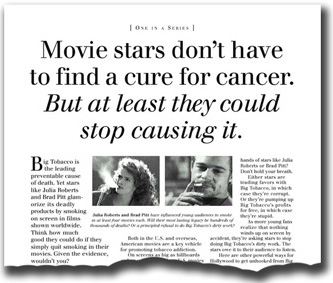
But Implementation Poses Multiple Challenges
Hazardous Hollywood:
Clearing Tobacco from Films Would Avert Deaths Worldwide at Virtually No Cost
by Jonathan R. Polansky, Principal, Onbeyond LLC, Fairfax, Calif.; and Stanton A. Glantz, Ph.D., Professor of Medicine, University of California, San Francisco

Motion pictures are powerful marketing mechanisms for tobacco. Thanks to U.S. research on the dangers of on-screen exposure, however, the risk posed to young audiences is attracting worldwide attention and compelling action.
Pressure is mounting from all fronts. The World Health Organization (WHO) and major U.S. health groups are urging film industry reforms to prevent future addiction and death. India is pursuing a January 1, 2006 end to tobacco imagery in all films and TV programs produced and seen within the country. And pediatricians, youth and shareowners are lobbying the media giants that own the major Hollywood studios to protect audiences both inside and outside North America.
Research Reveals…
To date, one of the most significant studies to look at the promotional effect of on-screen smoking followed 2,600 New England 10- to 14-year-olds for two years to isolate the influence of movie smoking from all other personal, family and social factors known to predict smoking initiation. Published by M. A. Dalton and cohorts in the 2003 Lancet (362(9380): 281-5), the results showed that 52 percent of smoking initiations in this age group were attributable to exposure to on-screen smoking.
The study also showed the dose-response relationship between exposure and smoking risk: Adolescents in the highest quartile of exposure were almost three times more likely to start smoking than those in the lowest quartile. Furthermore, nonsmokers’ children were more powerfully influenced than the children of smokers.
Congruent with a decade of other peer-reviewed research into the promotional effect of smoking on-screen, the results of this cohort study indicate that on-screen smoking is the primary recruiter of a new generation of U.S. smokers. The accompanying commentary by S.A. Glantz in the same issue of The Lancet (362(9380): 258-9) estimates that 390,000 teens start smoking annually because of on-screen exposure. Of these, 120,000 a year will ultimately die from tobacco use — more than the current U.S. death toll from murder, suicide, drug use and HIV/AIDS combined.

Product Placement and Publicity Are Industry Priorities
In effect, independent researchers have confirmed why tobacco companies have long valued film as a marketing channel. Confidential tobacco company documents discovered in the course of U.S. lawsuits against the firms reveal systematic product placement programs beginning soon after tobacco advertisements were barred from U.S. airwaves in 1970. Internal memoranda and contracts with product placement agents show that Philip Morris (alias Altria), American Tobacco, Brown & Williamson and RJ Reynolds (since merged into British American Tobacco) invested millions of dollars to get their brands into popular films.
Philip Morris also concluded that getting smoking per se on screen was vital to tobacco’s future social acceptability. “We must continue to exploit new opportunities to get cigarettes on screen and into the hands of smokers,” exhorted Hamish Maxwell, then president of Philip Morris International and later chairman of Philip Morris Companies, in 1983. “[M]ost of the strong, positive images for cigarettes and smoking are created and perpetuated by cinema and television,” an advertising agency reported to Philip Morris in 1989.
Tobacco-company files list more than 400 film productions contacted between the mid-1970s and mid-1990s. Brown & Williamson arranged with Sylvester Stallone to smoke its brands in five films for $500,000 (http://legacy.library.ucsf.edu/tid/cuf33f00). Philip Morris bought brand appearances and the right to review the final edit of Superman II (http://legacy.library.ucsf.edu/tid/hgt85e00). RJ Reynolds’ products appear in a series of John Travolta’s early films. The company also maintained a list of more than 180 Hollywood figures supplied with free cigarettes. Even non-commercial rebels like director John Cassavetes publicized its brands (http://legacy.library.ucsf.edu/tid/qxn61d00).
Policing Proved Problematic
U.S. congressional hearings forced the tobacco industry to pledge a self-policed end to paid product placement in motion pictures in 1990. Subsequently, tobacco documents show, some placement programs merely slowed, contradicting expenditure reports that tobacco companies are required to file with the U.S. Federal Trade Commission. In the early 1990s, at least one U.S. operation was shifted to the United Kingdom. (And as recently as 2002, Philip Morris ran a Paris-based program to “help” independent film productions -- http://www.culture.gouv.fr/culture/infos-pratiques/financement/financ-cine/production.htm.)
In 1998, the Master Settlement Agreement between tobacco firms and state prosecutors from dozens of U.S. states barred compensated tobacco brand display in any venue or entertainment open to young people. However, film surveys find brand display in U.S. films continued after 1998, and the total screen time devoted to smoking actually increased.
Ten years of effort by large nongovernmental health organizations to educate U.S. filmmakers about the hazards of including tobacco on screen have failed to make a difference. From 1999 through 2004, 80 percent of all live-action feature films released by U.S. film studios included smoking: 90 percent of R-rated films (under 17 admitted with parent or adult guardian); 80 percent of PG-13 films (parental guidance recommended for age 13 and below); and 40 percent of unrestricted PG and G-rated movies.
Counterbalancing Policies Proposed
Smoke Free Movies (SFM), an initiative based at the University of California-San Francisco’s Center for Tobacco Control Research and Education, estimates that U.S. teens receive more than half of their exposure to on-screen smoking from youth-rated (G/PG/PG-13) films and the rest from R-rated films. Films rated G and PG contribute only 5 percent of adolescent exposure. Based on research results, SFM has developed policy proposals to alter film industry practices permanently, verifiably and voluntarily (full discussion at http://smokefreemovies.ucsf.edu/). In brief:
- Rate new smoking movies “R,” with the sole exceptions being portrayals of actual historical figures who smoked (e.g., Winston Churchill) or the unambiguous reflection of the dangers and consequences of tobacco use.
- Certify no pay-offs in the closing credits of any smoking film.
- Require strong anti-smoking ads before smoking films of any rating.
- Stop identifying tobacco brands in films.
Outlined at a U.S. Senate hearing in May 2005, all four proposals are endorsed by WHO, the American Medical Association, American Academy of Pediatrics, American Legacy Foundation (established by the 1998 Master Settlement Agreement), American Heart Association, Los Angeles County Department of Health Services and a host of others. The American Lung Association and the Campaign for Tobacco-Free Kids have endorsed the “R” rating proposal.
Advocacy Builds Momentum
SFM has adopted a push-pull approach to advocacy. To raise the “cost” of current practices in the film industry, it holds individuals and studios accountable in confrontational ads placed in the Hollywood trade press and also informs autonomous public pressure campaigns by youth, pediatricians, shareowners and others in the United States and abroad.
SFM also seeks to lower the “cost” of industry cooperation. It supports genuine dialogue with the film industry and encourages established civil society groups and public officials to intervene with the top executives of the media conglomerates that own the major studios. Rather than embarking on the impossible task of educating the American public en masse, SFM concentrates on mobilizing existing organizations and concentrating resources on key leverage points and time-sensitive opportunities to alter corporate behavior.
SFM does not expect revolutionary changes. (Film studios will no doubt first seek to lower their political vulnerability by clearing tobacco out of G and PG “family movies.”) The question is, how long can the media companies afford to defend the tobacco industry’s interests at great reputational, political and possibly legal risk to themselves? Advocates’ persistence and a growing base of organized support will finally lead one company to forswear smoking in youth-rated movies and claim the mantle of social responsibility. The others will then necessarily follow suit.
Meanwhile, the film industry is employing diversionary tactics reminiscent of the tobacco industry itself, which uses fronts to snipe at advocates, obfuscate research and delay meaningful change as long as possible. These same techniques are being used to postpone and possibly dilute India’s policy to end smoking in future movies and TV broadcasts. In fact, protests from some parts of the Indian film industry appear to follow the script written by a Philip Morris public relations firm to stop U.S. anti-product placement legislation in 1989 (http://legacy.library.ucsf.edu/tid/lan87d00).
A sound policy in Bollywood (and the South Indian film industry) and Hollywood would protect hundreds of millions of young people worldwide. Because Hollywood exports dominate 60 percent of the motion picture box office in most overseas markets, WHO focused on “tobacco-free film” on World No Tobacco Day, 2003. Advocates in a dozen nations joined the Smokefree Movies Action Network in global publicity events in early 2005. The next International Day of Action, giving parents a voice, is scheduled for February 28, 2006, just prior to the 78th Annual Academy Awards®.
While countries with different exposure patterns, legal systems or rating regimes might adopt approaches other than those SFM has developed in the United States, advocates caution that simple rules are the easiest to enforce. Exceptions should be few and specific. Policies must be judged by their actual effectiveness, not the comfort they provide opponents of change.
Closing Credits
Faced with revealing research and reaction, why does the film industry resist life-saving measures? Filmmakers already calibrate such elements as violence, sex and foul language to achieve a desired rating for commercial reasons. Why not simply include tobacco, the only imagery conclusively shown to harm the audience physically, in this mix? Does compensated product placement continue?
Advocates are now less concerned with how smoking gets into movies than with how to get it out. But SFM estimates that Hollywood’s annual crop of new U.S. smokers alone is worth $3.2 billion to the tobacco companies in lifetime sales revenue (net present value). Either the film industry and the ad-driven media corporations that own it still gain from tobacco appearances, in which case they are murderously corrupt, or they are doing all this for free, in which case they are criminally stupid.
No matter what the circumstances, it is time for cinema, and cinema goers, to be delivered from this dilemma.